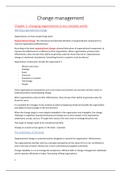Change management
Chapter 1: changing organizations in our complex world.
Defining organizational change
Organisations are how we get things done.
Organizational change: The intentional and planned alteration of organizational components to
improve organizational effectiveness.
According to the book organizational change: planned alterations of organizational components to
improve the effectiveness or efficiency of the organization. When organizations enhance their
effectiveness, they increase their ability to generate value for those they serve. Organizational
change is intentional and planned. Something formal or systemic must be altered.
Organization components include the organization’s:
- Mission and vision
- Strategy
- Goals
- Structure
- Processes or systems
- Technology
- People
Some organizational components such as structures and systems are concrete and thus easier to
understand when contemplating change.
When organizations enhance their effectiveness, they increase their ability to generate value for
those the serve.
It is essential for managers to be sensitive to what is happening inside and outside the organization
and adapt to those changes in the environment.
When the change target is more deeply imbedded in the organization and intangible, the change
challenge is magnified. Sustained behavioural change occurs when people in the organization
understand, accept, and act. Through their actions, the new vision or strategy becomes real.
The target of change needs to be considered carefully.
Change at a social service agency in the book = example.
The orientation of this book
Organizational change is a planned activity designed to improve the organization’ effectiveness.
The organizational member who has a broader perspective on the value of his or her contributions
and on the task at hand is likely to be a more committed and capable contributor.
Change capability is a core managerial competence. Without skills in change management individuals
cannot operate effectively in today’ fluctuating shifting organizations.
1
,The knowing-doing gap: knowing the concepts and understanding the theory behind organizational
change are not enough. Managers need to become effective agents of change, possessing the will
and skills to make positive change happen.
- Change capability has become a core managerial competency
• But managers’ abilities to deliver on change are modest at best
Environmental forces driving change today
Much change starts with shifts in an organization’s environment.
Sometimes organizations are caught by surprise by environmental shifts, while others have
anticipated and planned for new situations.
Environmental scanning and early warning systems allow for action before customers are lost or
provide paths to new customers and or new services.
Environmental forces driving change (PESTEL factors)
- Political changes
- Economic changes
- Social, cultural, and demographic
- New technologies
- Legal changes
- Ecological/ environmental factors
Turbulence and ambiguity define the landscape for both the public and private sectors.
Example: Toyota or GM
Failed to implement changes in a timely manner. Organizations find themselves influenced by
fundamental forces: changing social, cultural, and demographic patterns.
Martec’s law
- Technologies change exponentially fast, while organizations change logarithmically slowly.
The more time progresses, the greater the distance between the two becomes.
Capacity vs demand
2
,Responses to the external environment can escalate risks
When economy is low, the fertility rate is high.
Companies appear to be ill prepared to deal with this aging population. With aging populations
organizations can expect pressures to manage age prejudice more effectively. Innovative solutions
will be welcomed by aging members of the workforce and an increasing necessity for employers.
New organizational forms and management
Challenges due to environmental change
Macro changes and impact
- Digitalisation leading to
• Faster information transmission
• Lower cost information storage and transmission
- Integration of states and opening of markets
- Geographic dispersion of the value chain
- All leading to globalization of markets.
New change tool: Social media has altered thinking about change management. It has changed how
information is framed, who frames it and how quickly it migrates from the few to the many.
→ The watchword for change leaders is be aware of technological trends and be proactive in
considering how to respond to organizationally relevant ones.
The external political landscape of an organization is a reality that change leaders need to pay
attention to and figure out how to engage. If they are attentive and nimble, their interests will be
better served.
New organizational forms and competitive dynamics
- Global small and medium-sized enterprises
- Global constellations of organization (networks)
- Large, focused global firms
- All leading to:
• Spread of autonomous, dislocated teams
• Digitally enabled structures
• Intense global rivalry and running faster while seeming to stand still
As organisations become global, they need to clarify their own ethical standers. Not only will they
need to understand the rules and regulations of each country, they will also have to determine what
norms of conduct they will work to establish for their organizational members and what constitutes
acceptable and unacceptable behaviour.
The politics of globalisation and the environment have created opportunities and issues for
organisations. The politics of the world are not the everyday focus for all managers but change
leaders need to understand their influence on market development and attractiveness
competitiveness and the resulting pressures on boards and executives. (E.g. influence of Brexit,
Trump winning)
3
, Implications of worldwide trends for change management: The economic globalization of the world,
the demographic and coals shifts around the world, technological changes, environmental and
ecological pressures and the upheaval and political and economic uncertainties around the world
form the reality of organizational environments.
→ If we do not disrupt ourselves, our competitors will.
New management challenges
- Greater diversity
- Greater synchronization requirements
- Greater time-packing requirements
- Faster decision making, learning and innovation
- More frequent environmental discontinuities
- Faster industry life cycles
- Faster newness and obsolescence of knowledge
- Risk of competency traps where old competencies no longer produce desired effects
- Greater newness and obsolescence of organizations
Common management responses to
Competitive pressures
- Running hard, but for all purposes standing still
• Called the red Queen phenomenon
- In global competition, what matters is not the firm’s absolute rate of learning and
innovation, but the relative pace of its development compared to its rivals.
We life in a VUCA world
- Volatile
- Uncertain
- Complex
- Ambiguous
Dimensions of change
Continuous change
- incremental change: you go step by step.
- organizations are more emergent and self-organizing where change is constant, where
change is constant, evolving, and cumulative.
Episodic/ discontinuous change:
- organizations are having significant inertia.
- Change is infrequent and discontinuous.
- (reengineering programs: planned examples of injecting significant change into organization)
Programmatic, proactive, or planned change or reactively in response to external events:
- occurs when managers anticipate events and shift their organizations as a result.
Four types of organizational change
Nadler and Tushman define four categories of change
Tuning
4







